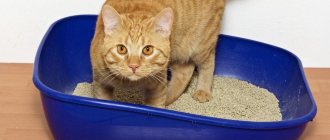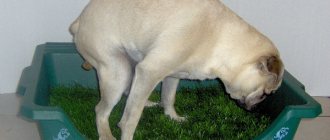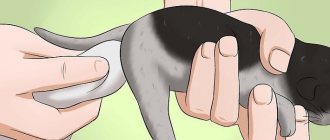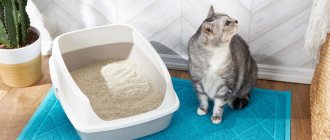The process of litter box training can be quite slow, and you need to be mentally prepared for this. Once in a new home, the pet will experience stress from the change of environment. Before he engages in the training process, he must calm down.
For an adult cat that has already been trained to use the litter box, a change of residence is unlikely to interfere with the ability to navigate the new environment and begin using the toilet correctly. The situation will be much more complicated if a pet from a shelter or from the street appears in the house. Owners need to prepare themselves in advance for the hard work ahead.
At what age does training begin?
The right recommendations will help speed up the long process. Kittens are also children, so there is no certain age for litter box training to be easy and quick. You can force an animal to go potty at 2 months or after 3 months - it depends on its intelligence and learning ability.
If a baby lives with a mother cat, he copies her behavior. The two-month-old kitten is already coping with the task on his own. If the mother is not nearby, the owner can train the cat to use the litter box.
It is not difficult to train a kitten to use the toilet in an apartment, especially when there is a cat nearby, even at 1 month, if the pet is smart. It’s not too late to do this even at 3 months.
Nothing works out
Read our second article on this topic: How to stop a cat from shitting in the wrong place - you will learn several new recommendations that will help you solve this problem.
Let's give a few more tips to help you train a kitten or adult cat to use the litter box.
Once again, pay attention to your tray and filler. Use the most neutral filler possible, and do not wash the tray with special cleaning products so that it does not smell of chemicals. Let a special place smell better than the toilet, it is more pleasant for the cat than a chemical smell. And in choosing the ideal litter box, our article with a rating of cat litter boxes will help you: How to choose a litter box for a cat.
The process of training an adult cat to use a litter tray is not quick. Be more restrained in your emotions, let yourself understand that you and your cat may need up to a month so that he can fully switch to a new habit for him. During this entire time, according to the plan and instructions in the article, do everything to get the cat used to the new place. We described everything in the instructions above.
The kitten shits on the rug and carpets. A temporary remedy for unwanted trips to the toilet in inappropriate places can be the procedure of treating these places with the smell of citrus fruits - lemon, orange, pomelo and others. Cats do not like such smells and will not go to the toilet in this place anymore.
There is no time to train a kitten to use a litter box. At an early age, it is important to take the kitten to the litter tray quite often. But if you have little time, you are often at work or are absent for other reasons, try buying a cat toilet training spray at a pet store.
The kitten is eating litter, what should I do? There may be several reasons for this behavior, from a banal misunderstanding due to age, up to a lack of minerals. In any case, start with the following steps:
- Buy him some corn litter. It is harmless and absorbs moisture well. Once ingested, it dissolves easily as it is made from corn. The only negative is it's expensive. But you will only need it for the first time, until the kitten understands that there is no need to eat the litter.
- For the sake of prevention or in cases where the kitten eats too much litter, take it to the veterinarian. There, they may give recommendations on purchasing mineral complexes and vitamins.
- You can also cover the tray with a grid, which will block access to the filler itself. The mesh should be fine so that the kitten does not fall through and does not experience discomfort while on such a grid. However, this should be the last item on the list. Small kittens must be accustomed to the litter.
My cat goes to the toilet in flower pots. Cats often actually like the smell of the soil; this is a natural reaction. You can scare away due to two things:
- Cover the surface of the soil with small pebbles. This will reduce the smell from the soil and will not harm the plants.
- You can put orange or lemon peel on the surface. Cats don't like the smell of citrus fruits.
Choosing a litter box for a kitten
An incorrectly selected tray is one of the first factors that will prevent you from teaching a small kitten to order. Below we consider the types of devices:
- open without mesh;
- open with mesh;
- tray-house;
- self-cleaning.
The correct tray for a cat is wide and with high sides. This is a general requirement for each type.
Open without mesh
A tray without a mesh will not have to be washed every day, and the animal will not injure its paws while trying to dig. But not every type of litter is suitable for it: the cat will carry it around the apartment and scatter it around the tray.
Open with mesh
More complex design. A net is installed on the container where the animal sits. Costs more, but is more hygienic. You can put any filler into the tray; it is inaccessible to the cat.
There are disadvantages:
- The mesh needs to be washed daily.
- The baby will still scratch the surface and may injure his paws.
The main disadvantage of both types of trays is their openness, which makes it more difficult to train a kitten to go to the toilet.
Tray house
An excellent choice for a small living space. It can be placed in the bathroom or hallway. It’s not difficult to make it yourself: the main thing is not to forget about the removable lid to make it convenient to clean. With or without mesh – the owner’s choice.
Important: You can buy an ordinary tray and make a tall, lightweight lid yourself.
Self-cleaning
Premium category trays. Almost no owner intervention is required. Simple models are equipped with a rake for leveling the filler and removing used lumps, a carbon filter to eliminate odors, and a silent motor with which this design operates.
The most expensive models require a constant connection to the network and sewerage.
How to choose a tray
You can pick up a tray for a kitten at any pet store. It is better to choose a large container at once. The kitten will grow very quickly and the small container will quickly become unusable. If you do not plan to use filler, then you should take a vessel with low sides.
Many cat potties have a lattice included. On the one hand, it is convenient - the cat will not wet its paws, even if it is “small” in an empty container. On the other hand, the animal, following instinct, will bury its feces and cling to the bars with its claws. This may cause pain to the kitten, and he will refuse to return to the place next time. Therefore, the issue with the grid is very ambiguous.
The shape of the container is not as important as all other design features. The litter box should be comfortable for the kitten, not for you. The main thing is that the container is spacious and made of high-quality plastic.
© shutterstock
Filler selection
The filler is selected under the tray.
Important: cats do not like scented toilet granules, so using them will not give the desired results.
clumping
Available with or without flavoring. The clumping product is hygienic and easily absorbs moisture and unpleasant odors. The main rule of any litter: the smaller the kitten, the smaller the granules.
Zeolite
Zeolite filler is more expensive than wood filler, but is consumed more economically and absorbs moisture better. It does not stick to the kitten’s paws or fur if a special mat is placed under the tray.
Woody
Cats can taste the litter. The safest option in this case is wood. But without a special rug, the kitten will carry it around the apartment on its paws.
Grain and pulp
Both types are environmentally friendly, relatively inexpensive and made from organic substances. If the kitten accidentally swallows particles of the filler, it’s not scary. Grain and pulp products clump easily.
Silica gel (hazardous to animals if eaten)
One of the most expensive types. This is a substance that is placed in boxes with shoes and bags to absorb moisture and odors. The silica gel filler does not stick to the kitten's fur and paws and does not create a stench, but if there is too much water in the tray, a puddle may form.
It is best to place this litter under the net so that the kitten does not accidentally eat it.
No filler
Need a self-cleaning tray. There is no point in giving up filler in a conventional device. All problems can be solved in other ways:
- spreads on its paws - buy a special mat, then all the granules will remain on it;
- refuses to use - most likely, the kitten does not like litter with a smell or too hard granules;
- better than newspapers - printing houses use toxic ink, the fumes of which are dangerous;
- expensive - the cheapest filler is wood.
Potty training
You need to use different methods to train a small kitten and an adult cat to use a litter tray. Much depends on the character of the animal, but almost all pets are successfully toilet trained. With some effort and patience, you can deal with any capricious creature.
Training a kitten to use the litter box
You need to start training as soon as the baby appears in the house. No need to wait until he grows up a little. The smaller the animal, the easier it is to toilet train. Ages from 1 to 3 months are considered the most optimal.
It's not at all difficult to train a small kitten to use the litter box.
Experienced cat lovers advise following the following fundamental points:
- If possible, you need to find out from the breeder what type of litter was used, where the potty was and how often the cat visited it. Often, experienced breeders themselves give along with the kitten a little litter from the mother's tray or pieces of paper stained with the kittens' urine. These “gifts” need to be placed in a new pot.
- It is necessary to let the baby get acquainted with his toilet. Sometimes they even advise you to help him a little and dig in the pot using his own paws. These actions can awaken natural instinct, and the animal itself will understand everything.
- For the first 2-3 days after relocation, do not leave your pet for a minute; you need to constantly monitor it. As soon as he starts fussing, trying to hide in a secluded corner and sit down, immediately take him to the toilet.
- Most often, kittens defecate immediately after feeding or after sleeping. To develop a useful habit, the animal must be put in a pot as soon as it wakes up or eats.
- You should not hold your baby by force. You only need to act with affection.
- If a pet defecates in a place not intended for this, then it is necessary to transfer the excrement to a pot, and thoroughly wash the crime scene with soap and treat it with odorous substances that cover the smell of urine. The culprit must see all this.
If the kitten does all its business in the potty, then you need to caress it, stroke it and praise it.
Potty training an adult cat
When raising a mature cat, follow the same tips as when training kittens. But you will have to work with an adult animal a little longer, because he has already formed his own hygiene habits. A cat adopted from another home will be easier to train than a street cat. All you have to do is take his old tray. Usually pets immediately recognize their toilet and go to it.
It is a little more difficult to litter train an adult cat than a kitten.
A street stray cat will require increased attention and patience. Experienced cat owners advise limiting his movements to the space of one room where the cat’s potty is currently located. You can only let your pet out while feeding.
First, a mixture of earth and sand is poured into a plastic container. This composition is more familiar to the cat, and he will be happy to bury his excrement in it. Add filler little by little and gradually replace the sand-earth mixture completely. After a few days, when the animal regularly visits its potty, the next room is opened for free access.
At the same time, it is necessary to close all possible and convenient secluded places for criminal acts: behind the closet, sofa, in flower tubs, etc.
With a stray street cat you will have to tinker quite a bit to train him to use the litter box.
There are specimens that stubbornly refuse to recognize the tray and continue to shit in their favorite place. In this case, it is recommended to simply put the potty there and let the cat go there for now. After waiting for some time, the box is gradually moved in the direction of the desired dislocation. There is no need to rush, 10–15 cm per day is enough.
You should not leave your shoes within the cat's reach, because the smell may attract the animal and it will mark your shoes and boots.
Using a spray for litter box training
To facilitate the learning process, you can use special sprays to train cats to use the tray, which contain specific aromatic components and attract cats with their smell . These substances help develop the habit of defecating in the potty.
The most commonly used means are:
- Api-San;
- Antishkoda;
- Himola.
The smell of litter box training spray attracts cats.
The spray must be applied to a piece of paper, which is then placed on top of the filler in the pot. You can simply spray the granules themselves. There is no need to spray too much of the drug, as an overly strong smell can also scare away the animal. Experts recommend using the spray in small quantities several times a day. When the pet gets used to doing all its business in the toilet, the amount of the sprayed drug is gradually reduced and then its use is stopped.
The use of special sprays can significantly shorten the process of litter training.
There is another group of drugs that do not attract with their smell, but, on the contrary, repel. They should be sprayed in places not intended for the toilet, but which the cat has chosen to relieve its needs. First, all traces of the “crime” are removed, the surface is thoroughly washed with warm water and soap, then the drug is immediately applied.
The group of antigadins includes the following sprays:
- Antitag;
- BioVax;
- Nature's Miracle Pet Block Repellent Spray.
There are products that repel cats and stop them from pooping in inappropriate places and, conversely, attract cats to the litter box
Any pet store always has a large selection of drugs that repel cats with their smell. Sales consultants will help you choose the right product.
It should be remembered that some cats do not react at all to such odors. When teaching them, the use of such tools is pointless.
From personal experience. Our previous cat got into the habit of pooping behind the sofa. Spraying with Antigadin did not help at all. Ordinary whiteness turned out to be effective. It was her smell that the pet couldn’t stand.
We use a pot without filler
Some animals are happy to use a litter box without loose litter because they do not have the need to carefully bury their excrement. To prevent your pet from getting its paws dirty, this plastic toilet is equipped with a special grill. Training is carried out according to the usual scheme, with the only difference being that the potty will be empty.
Not all cats agree to go to an empty toilet. Some people just need to dig around and bury everything thoroughly. You just need to come to terms with this, add filler and give the animal some freedom of action.
Trays without filler are very convenient, but they must be washed after each bowel movement.
If your pet is already accustomed to a litter tray, you can still teach him to use an empty container. To do this, gradually reduce the number of granules and then stop pouring them altogether.
When accustoming your pet to a tray without filler, gradually reduce its amount.
From personal experience. Sometimes cats don't like having their claws cling to the mesh, so they may refuse to go into an empty litter box. This was the case with our cat. I had to buy a tray with a very fine grid and pour in the filler.
You can train your pet to go to the toilet. It's not as difficult as it might seem at first glance.
You can train a cat to go to the toilet on the toilet
The teaching technology is as follows:
- the pot is gradually moved 5–6 cm per day to the base of the toilet;
- then place newspapers, magazines or cardboard boxes under the tray and gradually raise it (2-3 cm each) to the level of the seat;
- gradually move the plastic toilet onto the seat;
- When the animal can easily jump to such a height and go to the toilet regularly, the tray is removed.
To train a cat to use the toilet, you must strictly follow the sequence of steps
On sale you can find various convenient devices for training cats to go to the toilet.
Plastic pads make it much easier to train your cat to use the toilet.
Time to train your pet to use the litter box
Every cat is very different, so the time it takes to potty train may vary. Some gifted individuals understand everything literally the first time, while others have to tinker with it for several weeks. When everything is done correctly and all necessary conditions are met, the training process rarely exceeds 1–2 weeks. If the animal refuses to go to the toilet equipped for it for a long time, then you need to find out the reason for this behavior and make the necessary adjustments to the training process.
Does toilet training depend on the breed?
The general consensus among cat lovers is that the ability to litter box train does not depend at all on the breed of the animal. The learning process is influenced by the individual character of the pet. Outdoor street cats may start walking right away, while representatives of expensive, luxurious breeds will become mischievous and capricious. The opposite situation can also happen.
From personal experience. The first cat that lived with us for a very long time was an albino, that is, he was white and completely deaf. But he learned to go potty instantly. He only shit under the bed in the nursery once. They put him in a pot and scolded him. How he understood everything is still unknown to me.
The process of training a kitten to the tray
Be patient to finish what you start.
Important: Light massage stimulates digestion and the bowel movement reflex; When you sit the kitten on the potty, you can stroke its tummy.
Stage one - getting to know each other
For the first time, they put the kitten in the tray several times, take his paw and help him “dig.” Let the baby not be afraid to sniff the pot and the filler: this way he will get used to the place.
Stage two – observation and assistance
It is possible that you will have to run after the kitten throughout the apartment and watch when it starts meowing loudly, squatting, spinning in one place and scratching its paw on the floor.
Then you need to immediately carry him to the tray and not let him go until he goes to the toilet.
It will not be possible to correct the situation in 1 day, but if everything is done correctly, the cat will definitely get used to it.
Stage three - strengthening the reflex
Now the kitten can be scolded for ignoring the toilet. But not too much. When cleaning up after your baby, you just need to throw everything in the litter tray and take the kitten there when he starts looking for a place to go to the toilet. This must be done without shouting.
Additional tips and tricks
- You cannot hit a kitten or poke its face into the dirt;
- the optimal layer of filler in the tray is 5 cm;
- if the breeder’s baby was constantly lying on moisture-absorbing diapers, you will have to be patient;
- The kitten should also be praised for small progress.
Common Mistakes
- Wrong size of granules: the smaller the kitten, the smaller they should be;
- too early or late litter box training;
- If the baby relieves himself on soft surfaces, you need to put a piece of cloth in the filler.
Is it possible to train an adult cat to use a litter box?
It is more difficult to toilet train adult cats if they previously went about their needs on the street or in any convenient place in the house. But of course there are chances for success.
How to toilet train an adult cat:
- Close all hard-to-reach corners in the house: the area under the sofa, behind the closet, behind the refrigerator, etc.
- Choose a comfortable litter tray that matches your cat's size.
- If the animal has previously gone to the toilet outside, purchase a special litter that imitates the natural composition of the soil.
- Place the tray in an accessible place for your pet. The best option is in the toilet room. But do not forget to leave the door ajar so that the cat can visit the bathroom at any time without the help of the owner.
- During the first days of living in the house, observe the cat’s behavior. When she wants to go to the toilet, she will become restless and puzzled. The cat will look for a secluded place. Place her in a tray and lock her in the toilet for a while, leaving her alone. Cats don't like to be watched at this moment.
- If your cat goes to the litter box, be sure to praise her. You can even reward them with a tasty treat.
- If the first attempt is unsuccessful and the cat goes elsewhere, do not scold it. Collect feces in a napkin and place it in the tray for a while. If the cat urinated, pour sand over the urine, collect it, and do the same thing - put the collected feces in the cat litter box. Next time, the animal will be able to determine by smell the place where it needs to relieve its natural needs.
- If the cat shows persistence and basically goes to the toilet in the wrong place, move the tray there. As soon as he gets used to his new toilet, move the accessory to the bathroom.
If an adult cat categorically refuses to go to the litter box, try training her using special sprays.
Possible difficulties
If all the recommendations are followed, and the kitten does not go to the litter box, do not despair.
Pet doesn't go into litter box
You need to buy a device that is larger, wider, with higher sides, and it will become easier to teach your cat to go to the litter box.
Pet ignores litter box
If the baby goes to the toilet everywhere, check that the rules for choosing the device, filler and place for the tray are followed. If an already accustomed kitten is mischievous, the advice is the same:
- the tray should be without traumatic elements, preferably without a mesh;
- filler – odorless;
- put it in a dark, secluded place so that the animal is not afraid of anyone.
If the recommendations are taken into account, the pet will be able to go to the toilet where it needs to be. The exception would be a kitten that is too small. A one-month-old baby will not understand what they want from him.
We train a kitten at different ages
Select the age of your kitten/cat so we can make more relevant and actionable recommendations for your case.
Kitten up to 3 months
It is a little more difficult to train a kitten under 3 months of age to go to the toilet in a litter tray than an older individual. Learning at this age occurs more slowly. Most likely, you will spend not 3, but 7-10 days, but you can train any cat.
For small kittens, it is better to place the tray in the room where they spend the most time.
For very young kittens, it is important to place the litter tray in the bedroom or living room where the kitten spends the most time. Having trained to the toilet after 2-3 weeks, you can gradually move the tray to a place that is more secluded for the kitten and convenient for humans, for example, to the bathroom or toilet.
At the moments when the kitten begins to travel around the room on its own, try to pay close attention to its behavior. Transfer the kitten directly to the litter box as soon as you notice that he has stopped and is alert without moving. This is a sure sign that he is thinking about the toilet.
Kitten from 3 to 6 months
This is the most suitable age for litter box training. Just follow the instructions and you will succeed. And remember, lovingly caring for your pet is much more important than scolding him.
Cat from 6 months
The older the cat, the more difficult it is for him to learn new habits. You will need more time, endurance and patience for the kitten to learn to go to the right place. Also, 6 months is a good age for teaching a cat to go not only to the tray, but also to the toilet. But if the cat has not even gone to the litter box before, you need to start progressively - with basic things.
Is it possible to train a baby to use the toilet of another cat?
Smell is the main safety criterion for cats. The kitten will not use someone else's potty. In this case, even neutral flavors will not help accustom the cat to the litter box.
In order for the baby to learn to use a device that has already been used, the tray must be disinfected and make sure that foreign odors have disappeared.
Cat in the modern world
To this day, this animal remains free and independent. Scientists decided to consider it a semi-domesticated species, since cats have changed little in their traditional behavior and habits since they were wild. A pet left without a home very quickly runs wild again and its hunting instincts kick in.
In nature, there are from 32 to 71 breeds of domestic cats. The data varies due to different opinions of representatives of felinological organizations.
Feral cats are predominantly solitary predators, but in survival conditions they can form small colonies close to their food source.
Toilet training
If home conditions do not allow for space for a litter box, you can train your cat to use the toilet in a different way. The process will take a long time: it will take 1-2 months. To accustom a kitten to the toilet, the tray is carried to it and raised little by little.
When the devices are at the same level, do this:
- the tray is placed on the lowered lid of the plumbing for 5-6 days;
- pour a little litter into the toilet and place the kitten on it;
- To prevent the animal from being scared, you can buy a special attachment.
Litter training a kitten is an important element of upbringing. You can’t do without this skill in an apartment. The owner will need to show will and perseverance. A Persian, a handsome British cat or a cat without a pedigree will learn everything if you don’t hit the baby or yell at him.
Timely training
It is advisable to accustom a kitten to the tray from an early age. From which one?
As soon as possible, ideally when he reaches four weeks.
Teaching a one-month-old kitten to order will be quite quick and easy.
According to the advice of veterinarians, this particular age limit is optimal for animals to learn new information and skills.
But this requires persistence on the part of the owner.
If the owner does not pay attention to the “dirty things” left in the corners of the apartment and silently removes them, then the pet will decide that this is in the order of things
Important! It is much more difficult to teach order to a two-month-old kitten, especially after he has been pooping wherever he wants for quite a long time!
If you took the baby from a nursery, where until now his mother was looking after him, then you should not flatter yourself with the hope that she instilled good behavior in him.
As a rule, cats do not train their kittens to use the litter box. Kids can simply copy her actions.
And even if small pets managed to adopt some good habits during the time spent next to her, there is a high probability that the skills will be lost when the situation changes.
Even if the cat mother set an exceptionally good example for the baby, separation from her can lead to a complete loss of this experience.
When a kitten turns one month old and is immediately separated from its mother, it experiences stress, no matter how friendly its new owners are to it.
The baby is lost and often does not control his natural urges.
Here, new owners should show restraint and teach the kitten to go to the litter box on their own.
How long will it take? It all depends on your persistence and the character of the baby.
What should the filler be?
The right litter will help you accustom your kitten to the litter box.
Clumping litters are made from bentonite clay and minerals. When wet, the composition turns into lumps, which can be quickly and easily removed using a special scoop or spatula. All that remains to be done is to pour the filler into the tray. Manufacturers of such fillers recommend covering them with a layer of at least 10 cm and completely replacing them every 5-7 days.
If you are the happy owner of a playful baby and are looking for an answer to the question of how to train a one-month-old kitten to use a litter box, this litter is not recommended. The thing is that kittens, in the process of changing teeth, constantly strive to try everything on the tooth; the filler sticks to the walls of the stomach and can even cause the death of the pet.
In the production of absorbent compositions, clay is used that has undergone a process of high-temperature drying and pressing. The granules have excellent absorbent properties and retain moisture well.
Wood fillers are pellets of pine sawdust. When wet, the composition disintegrates; it is easy to sift with a special scoop. They do not contain dyes or flavors, and can rightly be considered the most environmentally friendly fillers. The granules are changed in the tray every 4-5 days.
Mineral compositions are minerals of volcanic nature that undergo pre-treatment. Suitable for adult cats and can be combined with wood pellets. Zeolite has the highest absorbing properties.
In terms of their technical characteristics, paper, corn and grain are on the same level. They belong to the absorbent category and are suitable for both adult cats and small kittens.
The highest rates of absorption and efficiency are shown by silica gel fillers, which are made from polysilicic acid. When absorbed, the granules do not change their structure; the need for replacement can be determined by a change in color.
The safest (especially if the animal or owner suffers from allergies) are wood pellets. For owners of two or more pets, it is better to choose a silica gel-based litter; it saves time on cleaning and money.
If necessary, you can combine fillers, thereby ensuring maximum cleanliness of the toilet. The combinations of silica gel + mineral filler, mineral + wood, grain + wood received excellent reviews.
The filler is sold in both small and large volumes. For an adult cat for 1-1.5 months, 15-18 liters of filler are required, for a kitten - about 5 liters.











